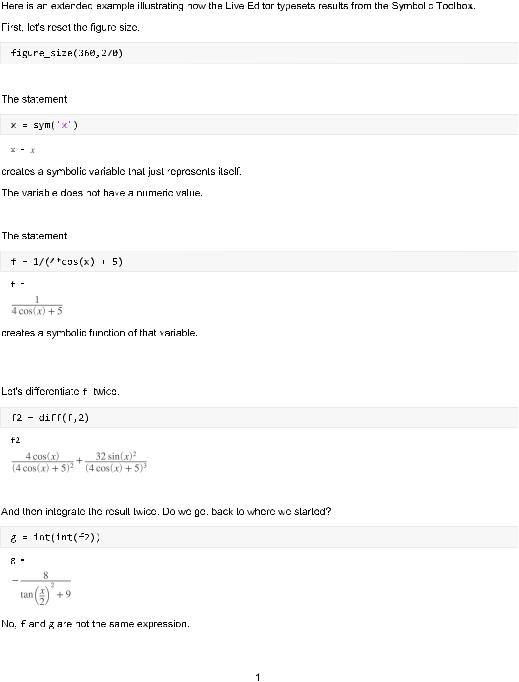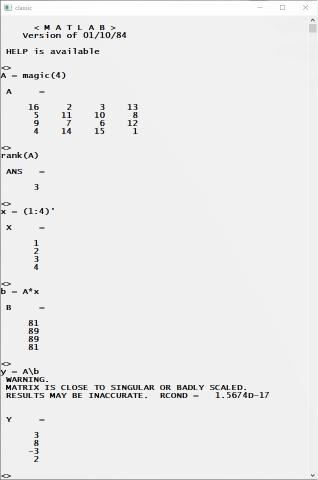
- •Prologue
- •Contents
- •1 The Creation of MATLAB®
- •1.1 Mathematical Origins
- •1.2 EISPACK
- •1.3 LINPACK
- •1.4 Classic MATLAB
- •2 Key Features of Classic MATLAB
- •2.1 Backslash
- •2.2 Colon Operator
- •2.4 Portable Character Set
- •2.5 Syntax Diagrams
- •2.6 User Function
- •2.7 Precursors
- •3 From Classic MATLAB to a Commercial Product
- •3.1 Developing MathWorks MATLAB
- •3.2 Functions
- •3.3 Dynamic Linking of Compiled Code
- •3.4 Language Changes and Extensions
- •3.5 New Functions
- •3.6 Toolboxes
- •3.7 Graphics
- •3.8 Flops Count
- •4 Evolution of MATLAB
- •4.1 Data Types
- •4.2 Sparse Matrices
- •4.3 Empty Matrices
- •4.4 Compiling MATLAB
- •4.5 The Pentium FDIV Bug
- •4.6 Cell Arrays
- •4.7 Structures
- •4.8 Numerical Methods
- •4.9 ODEs
- •4.10 Text
- •4.11 Evolution of the MathWorks Logo
- •5 Recent Developoments
- •5.1 LAPACK
- •5.2 FFTW
- •5.3 Desktop
- •5.4 Function Handles
- •5.5 Objects
- •5.6 Symbolic Math Toolbox™
- •5.7 Making MATLAB More Accessible
- •5.8 Parallel Computing
- •5.9 GPUs
- •5.10 Strings
- •5.11 Execution Engine
- •5.12 Development Process
- •5.13 Toolboxes
- •6 Success
- •Epilogue
- •Acknowledgments
- •A Syntax Diagrams for Classic MATLAB
- •References
- •Non-archival References

81:40 |
Cleve Moler and Jack Little |
Fig. 18. The appearance of the MATLAB desktop in 2019.
The MATLAB Live Editor notebook interface was introduced in 2016. MATLAB input, output and graphics are combined in a single interactive document. The document may be exported to HTML, PDF, or LATEX.
Figures 19–21 show an an extended example illustrating how the Live Editor typesets results from Symbolic Math Toolbox.
The “magic squares” from recreational mathematics ( -by- matrices containing the integers 1 through 2 for which every column, every row, and the two major diagonals have the same sum) have some interesting properties from a linear algebra point of view. It is for this reason that even the very earliest design for MATLAB included a function to generate magic squares— though the earliest documentation remarked only that the function magic produces “interesting test matrices” [Moler 1980]. The 1981 manual further says, “Magic square. MAGIC(N) is an N by N matrix constructed from the integers 1 through N**2 with equal row and column sums.”
Figures 22 and 23 show a demonstration using Classic MATLAB of various properties of a 4-by-4 magic square, including the fact that the sum of every row, column, and major diagonal is 34 and the fact that it is a singular matrix (because its rank is 3, not 4). Figures 24 and 25 show a comparable demonstration using today’s MATLAB Live Editor™.
5.8 Parallel Computing
Parallel Computing Toolbox™ (PCT) was introduced at the 2004 Supercomputing Conference. The next year, at Supercomputing 2005, Bill Gates gave the keynote talk [Gates 2005], using MATLAB to demonstrate Microsoft’s entry into High Performance Computing.
PCT supports coarse grained, distributed memory parallelism by running many MATLAB workers on many machines in a cluster, or on many cores in a single machine. [Luszczek 2009]
Proc. ACM Program. Lang., Vol. 4, No. HOPL, Article 81. Publication date: June 2020.

A History of MATLAB |
81:41 |
|
|
|
|
Fig. 19. Use of Symbolic Math Toolbox within MATLAB Live Editor (1 of 3).
Proc. ACM Program. Lang., Vol. 4, No. HOPL, Article 81. Publication date: June 2020.

81:42 |
Cleve Moler and Jack Little |
|
|
|
|
Fig. 20. Use of Symbolic Math Toolbox within MATLAB Live Editor (2 of 3).
Proc. ACM Program. Lang., Vol. 4, No. HOPL, Article 81. Publication date: June 2020.

A History of MATLAB |
81:43 |
|
|
|
|
Fig. 21. Use of Symbolic Math Toolbox within MATLAB Live Editor (3 of 3).
Proc. ACM Program. Lang., Vol. 4, No. HOPL, Article 81. Publication date: June 2020.

81:44 |
Cleve Moler and Jack Little |
|
|
|
|
|
|
|
Fig. 22. Exploring simple properties of magic squares in Classic MATLAB (1 of 2).
By far the most popular feature of the PCT is the parallel for loop command, parfor. This allows the creation of “embarrassingly parallel” jobs with many variations of a single program and no communication between processes.
Parallel Computing Toolbox rests upon the implementation of the MPI (Message Passing Interface) library [Gropp et al. 1998; Snir et al. 1998]. MATLAB provides message-passing functions that are
Proc. ACM Program. Lang., Vol. 4, No. HOPL, Article 81. Publication date: June 2020.

A History of MATLAB |
81:45 |
|
|
|
|
|
|
|
Fig. 23. Exploring simple properties of magic squares in Classic MATLAB (2 of 2).
high-level abstractions of functions described in the MPI standard; these include point-to-point communication, broadcast, barrier, and reduction operations. An important part of the design of the Parallel Computing Toolbox is that messages may be used to transmit or exchange arbitrary MATLAB data types, including numerical arrays of any precision, structure arrays, and cell arrays. In the general case, a single MATLAB message becomes two MPI messages: a short header message of known size that indicates the MATLAB data type and associated size information, followed by a payload message. The size information in the first message allows the receiver to prepare a buffer adequate to receive the payload. For certain small data sizes, the payload can be included in the header message, eliminating the need for a separate payload message. For complicated data types, the data array is serialized by the sender into a byte stream and then deserialized by the receiver, but for MATLAB data types that can be mapped directly onto an MPI data type, the serialization/deserialization process is skipped and the contents of the data array are sent directly. [Sharma and Martin 2009]
Proc. ACM Program. Lang., Vol. 4, No. HOPL, Article 81. Publication date: June 2020.

81:46 |
Cleve Moler and Jack Little |
|
|
|
|
Fig. 24. Exploring simple properties of magic squares in today’s MATLAB Live Editor (1 of 2).
Proc. ACM Program. Lang., Vol. 4, No. HOPL, Article 81. Publication date: June 2020.

A History of MATLAB |
81:47 |
|
|
|
|
Fig. 25. Exploring simple properties of magic squares in today’s MATLAB Live Editor (2 of 2).
Proc. ACM Program. Lang., Vol. 4, No. HOPL, Article 81. Publication date: June 2020.
